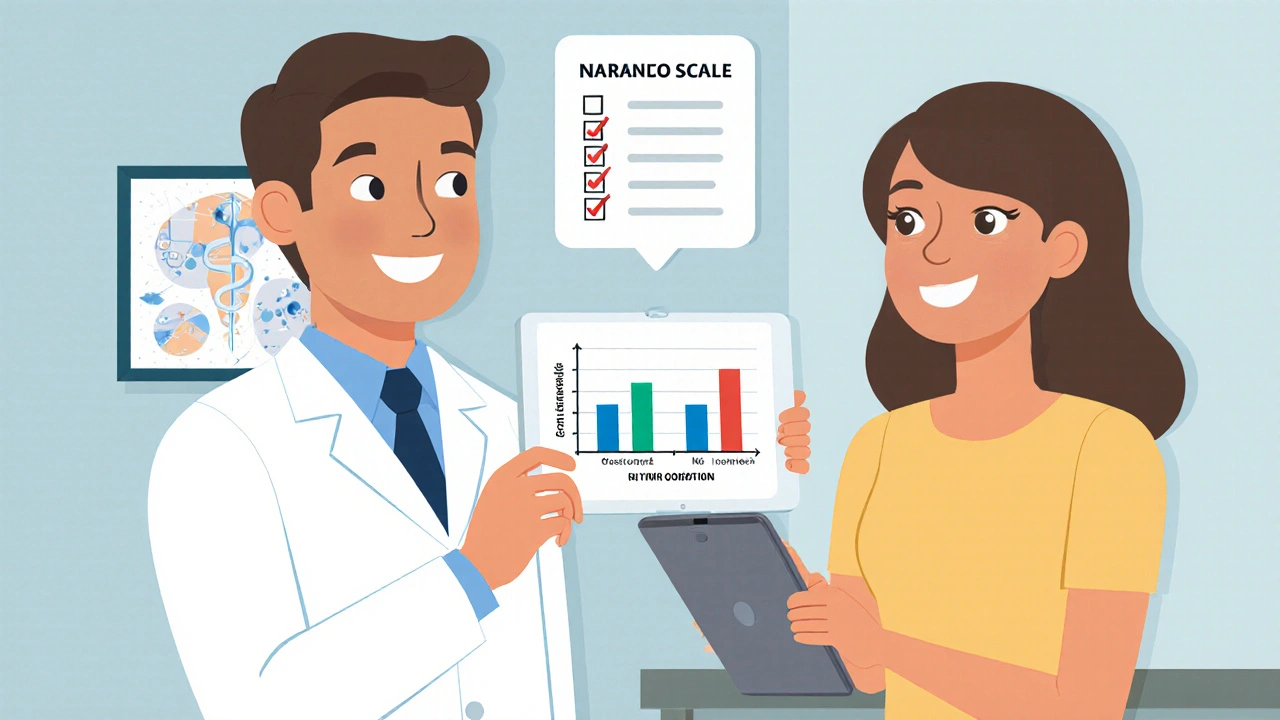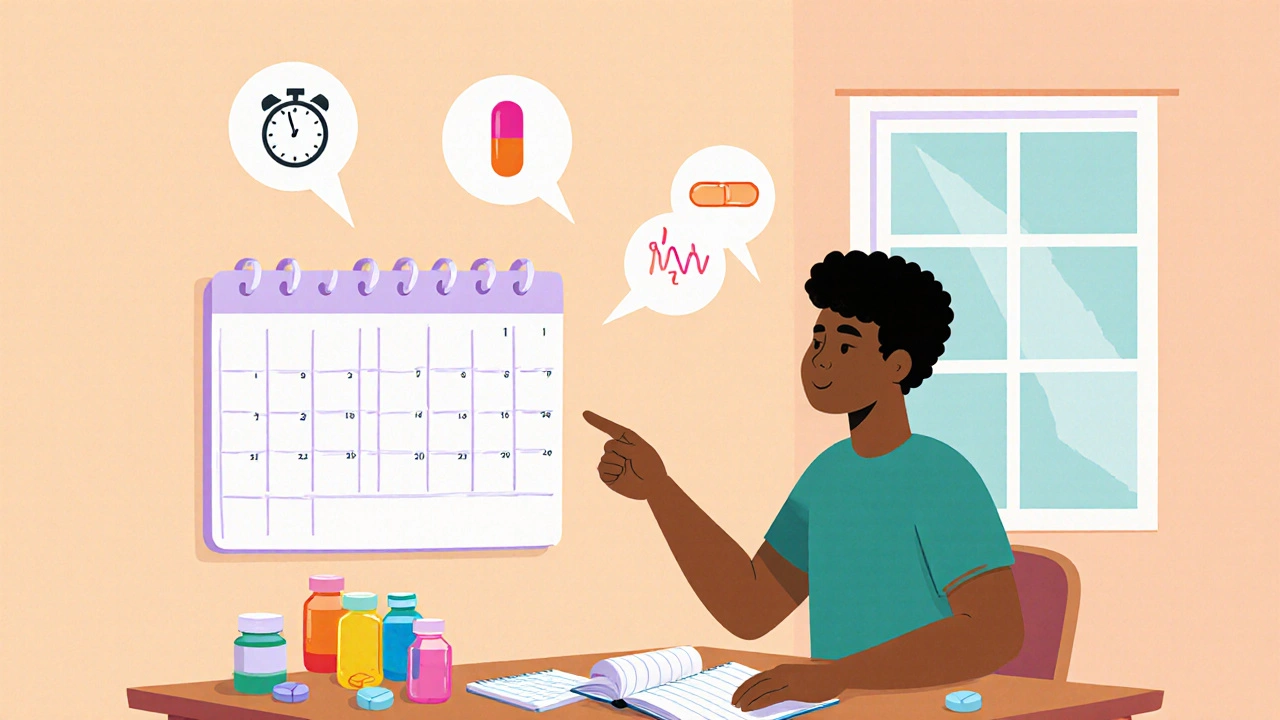Drug Side Effect Assessment Tool
Assess Your Symptoms
This tool uses evidence-based criteria from the article to help you determine if your symptoms are likely from medication side effects or your underlying condition.
Key Takeaways
- Look at when the symptom started relative to the medication start date.
- Check if the problem gets worse when the dose goes up or improves when the dose comes down.
- Use structured tools like the Naranjo Scale or a simple de‑challenge/re‑challenge under a clinician’s watch.
- Write everything down - time, dose, severity - in a symptom‑medication diary.
- Ask a pharmacist or doctor to review all your medicines, especially if you’re on five or more.
When you feel a new ache, nausea, or brain‑fog, the first question is usually “Is this my illness getting worse, or is my new pill to blame?” The answer matters for safety, cost, and how well your treatment works. Below is a step‑by‑step guide that lets you separate a Medication side effect an unintended physiological response that occurs at normal therapeutic doses from a Disease symptom a manifestation of the underlying condition being treated. Follow the process, use the tools, and you’ll avoid unnecessary tests, hospital trips, and medication changes.
1. Start with Clear Definitions
The World Health Organization defines a side effect as “an unintended response to a medication given at doses normally used for prophylaxis, diagnosis, or therapy.” In contrast, a disease symptom is simply what the illness does to you - fever from an infection, joint pain from arthritis, or low mood from depression. Knowing the labels helps you ask the right questions.
2. Temporal Relationship - When Did It Appear?
Time is the single most reliable clue. Most side effects show up within a predictable window:
- Immediate (minutes‑hours): drowsiness after diphenhydramine, hives after a penicillin dose.
- Early (1‑4 weeks): dry mouth from an SSRI, cough from an ACE inhibitor.
- Delayed (weeks‑months): weight gain with olanzapine, osteoporosis with long‑term steroids.
If a new complaint starts days after you begin a drug, keep it on the side‑effect radar. If the problem has been present for months before the prescription, it likely belongs to the disease.
3. Dose‑Response Relationship - Does the Dose Matter?
About 70 % of side effects are dose‑dependent. Raise the dose and the issue often intensifies; lower the dose and it eases. A disease symptom usually tracks the disease’s natural course, not the pill amount. For example, an ACE‑inhibitor‑induced cough gets louder when the dose climbs, while rheumatoid‑arthritis pain generally follows joint inflammation, not the blood‑pressure pill level.

4. Structured Assessment Tools
When intuition isn’t enough, clinicians turn to formal scales.
- Naranjo Adverse Drug Reaction Probability Scale asks ten focused questions (timing, prior reactions, alternative causes, de‑challenge, rechallenge) and yields a score that categorizes the reaction as definite, probable, possible, or doubtful.
- The de‑challenge‑re‑challenge method temporarily stops the suspect drug (under supervision) to see if the symptom fades, then restarts it to see if the symptom returns. Studies show about 85 % diagnostic accuracy when done safely.
These tools are especially useful for chronic diseases where symptoms and side effects overlap, such as depression (fatigue vs SSRI‑induced insomnia) or heart failure (dyspnea from disease vs beta‑blocker‑related bronchospasm).
5. Common Side‑Effect Patterns by Drug Class
Recognizing class‑specific clues speeds the decision.
| Drug Class | Frequent Side‑Effect | Usual Disease Symptom (for comparison) |
|---|---|---|
| ACE inhibitor (e.g., lisinopril) | Persistent dry cough (5‑20 % of users) | Chest tightness from asthma or heart failure |
| SSRI (e.g., sertraline) | Sexual dysfunction, insomnia | Depression‑related fatigue, insomnia |
| Antihistamine (e.g., diphenhydramine) | Daytime sedation, dry mouth | Allergy‑related itching, sneezing |
| Anticholinergic (e.g., diphenhydramine, certain tricyclics) | Memory lapses, urinary retention | Early dementia symptoms |
| Glucocorticoid (e.g., prednisone) | Weight gain, mood swings, osteoporosis | Rheumatoid‑arthritis pain, fatigue |
When you see a pattern that matches a drug class, flag it as a side‑effect suspect.
6. Polypharmacy - The More Pills, the Harder the Guess
Thirty‑five percent of patients on five or more drugs experience interactions that mimic disease progression. The biggest pitfalls:
- Drug‑drug interactions that create new symptoms (e.g., NSAID + antihypertensive causing kidney pain).
- Cumulative anticholinergic load causing confusion, especially in older adults.
- Overlap of side‑effects across multiple drugs, making the source blurry.
To untangle the web, conduct a comprehensive medication review with a pharmacist. Ask them to flag any overlapping side‑effect profiles and consider simplifying the regimen.
7. Special Populations - Seniors, Kids, Pregnant Women
Age and physiology shift the balance:
- Older adults often mistake anticholinergic side‑effects for age‑related memory loss - up to 20 % of new “dementia” diagnoses are drug‑induced.
- Children may not articulate nausea or headache, so parents need to watch for behavior changes soon after a new prescription.
- Pregnant patients have altered drug metabolism; a side‑effect that appears “normal” in the general population may be a warning sign for the fetus.
In these groups, maintain a tighter diary and lower the threshold for contacting a clinician.

8. Practical Step‑by‑Step Checklist for Patients
- Record the exact date and time you start each new medication.
- Log any new symptom with time, severity (1‑10), and context (eating, resting, other meds).
- Note dose changes - increase, decrease, or missed doses.
- After 1‑4 weeks, compare symptom timing to medication start. If they line up, flag as possible side‑effect.
- Discuss the log with your doctor. If they suggest a safe de‑challenge, pause the drug and watch the symptom for 48‑72 hours.
- If the symptom disappears, the doctor may restart at a lower dose or switch class.
- Keep the log even after the issue resolves - it helps future providers.
Digital tools like Medisafe or simple spreadsheet templates can automate timestamps and reminders.
9. Clinician‑Focused Workflow
Healthcare teams can embed the same logic into electronic health records (EHR). A typical workflow:
- When a new prescription is entered, the EHR auto‑generates a “Side‑Effect Tracker” note.
- During each visit, the clinician reviews the tracker, applies the Naranjo Scale, and decides on de‑challenge if appropriate.
- Pharmacy alerts flag high‑risk polypharmacy combos before the prescription is sent.
- Follow‑up calls within 7‑10 days after initiating high‑risk meds (e.g., opioids, steroids) capture early side‑effects.
This systematic approach cuts medication‑related emergency visits by about 28 % according to the MedShadow 2021 survey.
10. Quick Reference Table
Frequently Asked Questions
How long after starting a medication should I expect side‑effects?
Most predictable side‑effects appear within the first 1‑4 weeks. Immediate reactions (like hives) show up within minutes to hours, and chronic effects (like bone loss) develop over months.
Can I stop a medication on my own to see if a symptom is a side‑effect?
Never stop a prescription without talking to a clinician. A supervised de‑challenge ensures safety and gives reliable information.
What is the Naranjo Scale and how is it used?
The Naranjo Scale asks ten questions about timing, previous reactions, alternative causes, and response to de‑challenge/re‑challenge. Scores >9 indicate a definite drug reaction, 5‑8 probable, 1‑4 possible, and ≤0 doubtful.
Why do older adults often misinterpret medication side‑effects as new disease?
Aging reduces drug clearance and increases anticholinergic load, producing confusion, dry mouth, or urinary retention that resemble age‑related conditions. Up to 20 % of new dementia diagnoses are actually drug‑induced.
Is there any technology that helps differentiate symptoms from side‑effects?
AI‑driven tools like MedAware’s SafetyRx analyze EHR data and flag patterns with 91 % accuracy. Wearables that track heart rate or blood pressure can also separate medication‑induced changes from disease progression.


the sagar
October 24, 2025 AT 20:07New meds are just poison from the global elite.
Grace Silver
October 24, 2025 AT 22:20It feels like we are juggling two mysteries at once. One is the disease that already haunts us and the other is the silent whisper of a pill. When the timing lines up you start to see a pattern that most people overlook. Keep a simple log and let the facts speak.
Clinton Papenfus
October 25, 2025 AT 00:33The delineation between pathological manifestations and pharmacological adverse events warrants rigorous scrutiny. Temporal correlation constitutes the primary heuristic in clinical assessment. Dose‑response dynamics further elucidate causality. Utilization of validated instruments such as the Naranjo Scale enhances objectivity. A systematic documentation protocol is indispensable for longitudinal analysis. Ultimately, interdisciplinary collaboration optimizes patient safety.
Buddy Bryan
October 25, 2025 AT 02:47Listen, the first thing you do is map every new prescription on a spreadsheet. Mark the exact start date and dose, then flag any symptom that shows up within the next few weeks. If the complaint intensifies when you boost the dose, you have a side‑effect on your hands. Bring that chart to your doctor and demand a supervised de‑challenge. No one should have to guess whether their medication is killing them.
Jonah O
October 25, 2025 AT 05:00They dont want u to kno w that the pharma lobb i es are controling the whole thing its a chemtrail of pills in our veins. The side effects are just a way to keep the population docile while they push the next gen of vaccines. Look at the timing it always lines up with a new policy announcement. Dont be fooled by the glossy brochures they hand out at the clinic.
Aaron Kuan
October 25, 2025 AT 07:13Side‑effects are like sneaky ninjas, popping up when you least expect them.
Your diary is the sword that cuts through the mystery.
Nathan Comstock
October 25, 2025 AT 09:27If you think your disease is the only villain, think again. The pills you swallow are engineered to sabotage you, and the evidence is staring you in the face. Every cough after an ACE inhibitor is a silent alarm, not an asthma flare. The pharma giants profit from your confusion, and they flood the market with drugs that masquerade as cures. Wake up, question the script, and demand transparency before you become another statistic.
Terell Moore
October 25, 2025 AT 11:40Ah, the noble art of side‑effect detective work, a pastime for the truly enlightened. One must surely consult the ancient scrolls of Naranjo before daring to speak to a mere physician. The patterns are obvious to anyone who has ever read a label-if you’re lucky enough to notice them. Of course, the average patient will drown in a sea of jargon and pray for a miracle. It’s a pity that the healthcare system expects you to perform a PhD‑level analysis on a spreadsheet. But fear not, we, the self‑appointed arbiters of medical truth, are here to deconstruct your symptoms with flawless precision. Let us all bow to the grandeur of our collective expertise. Meanwhile, the drug companies continue their benevolent charade of curing nothing.
Amber Lintner
October 25, 2025 AT 13:53You call it sabotage, I call it progress. Those 'silent alarms' are just the body adjusting to life‑saving therapy. Stop dramatizing and trust the science.
Veronica Appleton
October 25, 2025 AT 16:07Great rundown! I’ve found that keeping a simple spreadsheet really helps when you discuss options with your doctor. Also, don’t forget to mention any over‑the‑counter meds you’re taking. Thanks for sharing such practical tips.
ram kumar
October 25, 2025 AT 18:20Another self‑important lecture, typical. I’ve seen less drama in a soap opera.
Ken Dany Poquiz Bocanegra
October 25, 2025 AT 20:33Keeping a symptom‑medication diary may seem tedious, but it pays off big time.
Each entry gives you a concrete piece of the puzzle that you can show to your clinician.
Start by noting the date, time, and dose of every new drug.
Write down any new ache, nausea, or brain fog with a quick severity rating.
If the symptom appears within days of starting the pill, flag it as a possible side‑effect.
Watch how the issue changes when you adjust the dose, if your doctor allows it.
A dose‑dependent flare is a strong clue that the medication is the culprit.
When you have multiple drugs, look for overlapping side‑effect profiles in the pharmacy’s alert system.
Sometimes a simple de‑challenge, done safely under supervision, clears up the mystery.
If the symptom vanishes, you’ve likely identified the offender.
If it persists, focus on the underlying disease and discuss further testing.
Don’t forget to review the official drug label; it lists the most common adverse reactions.
Sharing your diary with a pharmacist can uncover hidden interactions you never imagined.
The more data you gather, the more confident you’ll feel in making informed decisions.
Stay proactive, stay patient‑centered, and remember that knowledge is your best defense.